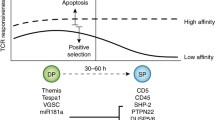Abstract
The acquired immune system is a complex and very effective defense against invading pathogens such as bacteria and viruses. T cells are central to the acquired immune system by controlling B and T cell activation and induction of T cell effector functions. The key event for T cell activation is the recognition of a specific antigen by the T cell receptor. During the past decade antigen recognition of T cells has been investigated intensively leading to new insights into the molecular mechanisms of T cell activation. In addition to the resolution of the molecular structure of the trimolecular complex (T cell receptor, peptide, major histocompatibility complex) functional studies have demonstrated the flexibility of the T cell receptor interaction with its ligand. These observations have had strong implications for the understanding of T cell selection, maturation, and repertoire maintenance. In addition, the flexibility of the T cell receptor has provided the basis for novel methods to dissect antigen recognition and define the repertoire of ligands for a given receptor. Here, we summarize recent progress on T cell recognition and method innovations with respect to future studies in autoimmune diseases.
Similar content being viewed by others
Author information
Authors and Affiliations
Additional information
Electronic Publication
Rights and permissions
About this article
Cite this article
Jacobsen, M., Cepok, S., Oertel, W.H. et al. New approaches to dissect degeneracy and specificity in T cell antigen recognition. J Mol Med 79, 358–367 (2001). https://doi.org/10.1007/s001090100230
Received:
Accepted:
Published:
Issue Date:
DOI: https://doi.org/10.1007/s001090100230




